
|   |

|   |
August 1, 2017  "Opportunity dances with those already on the dance floor." - Anonymous We are officially in the second half of the year. The longest day is behind us and looming ahead is the season of festivals and celebration. The sun begins its descent as the calendar is filled with numerous reasons to congregate and enjoy the many facets of this incredible country! # ELEPHANT GAIT IN A COLOMBO STUDIO 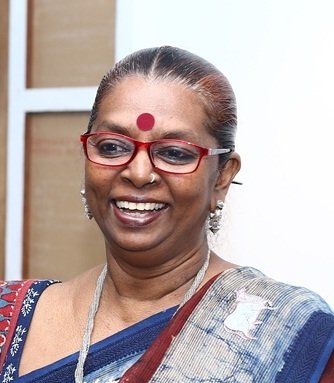 Upeka Having travelled to Sri Lanka and South Africa last month, my dance journal is filled with many impressions and jottings. In Colombo, I watched the incredible Upeka Chitrasena back in action. I had herded the four woman team from Arangham/Narthaki/Aalaap to Sri Lanka for a 4 day retreat where I insisted that they watch this exemplary dance company in action. Squeezed into two TUK TUKS, we dropped into a weekend dance class and were instantly enchanted by the discipline and dedication of the senior company dancers. In anticipation of a forthcoming performance, the stage dimensions were drawn out on the floor of the rehearsal space and Upekha was blocking the movements with pinpoint precision. I watched her mother, the 86 year old matriarch Vajira Chitrasena, beat her drums while supervising a fitness class for mature women. At the other end of the large space was her daughter who had recovered from an ankle injury and relentless in her quest for perfect symmetry and coordination from her dancers. Watching them perform GAJA GAMINI - gait of the elephant dance section - was a delight. Majestic, heavy and distinctly rounded in shapes, the physical vocabulary of this style of Kandyan dance (although this is a simplistic way of describing it) is worth taking a closer look at by all classical dancers from India. Weeks ago, I had posted a short clip of this sequence on my personal Facebook page and was instantly amazed at the large number of responses and emojis that filled that post. In respect of their choreographic copyright, I am not posting that clip on this page but am urging all dancers to plan a visit to the CHITRASENA DANCE SCHOOL if you find yourself in Colombo on any weekend. As pioneers who mined the dance culture of Sri Lanka for a modern nation, the CHITRASENA family planted the seeds of music and performance 75 years ago. Despite all the gory chapters of a violent civil war and uncertain times, this is one family that lives, breathes and dreams DANCE. Thaji - the grand daughter and the company's star - continues to enchant world audiences with her incredibly lithe body and unmatched artistry. youtu.be/hzRXfFbrQOA # SITA IN ZULU LAND 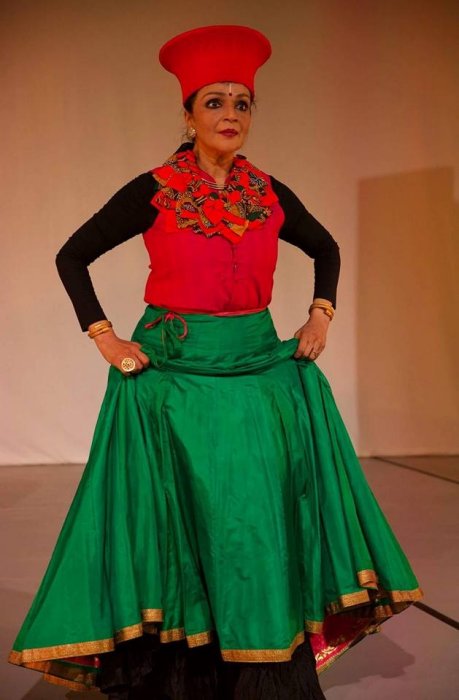 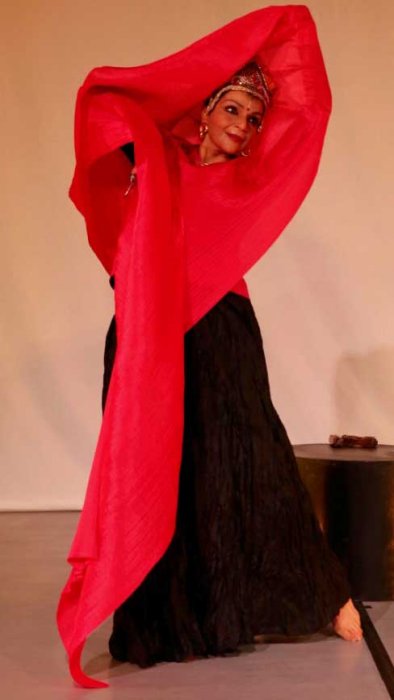 "You are black". I was told this as a matter of fact statement when I arrived in Cape Town. Racism, colour and segregation are alive and well although not in an overt way. Just 25 years after the dismantling of apartheid, the issues of Afrikaans, Indians and native South Africans are still being wrestled with, accompanied by all the ugly scars of a dark and brutal era that haunted and destroyed many a life. We Indians are inherently racist and deeply conscious of our skin colour. This is confirmed by the multi billion dollar cosmetic and matrimonial industry and continued expectations of a light skinned life partner. So to be told summarily that I was clubbed into the group considered "BLACK" elicited initial indignation. Yet this is exactly how native South African and Indians are viewed. Black and Afrikaans (descendants of the white supremacist race of Dutch and other European colonisers) are the only two categories. Recent student protests and rising indigenous sentiment have brought down the statues of once revered figures like Cecil Rhodes while the anger at false promises of free education for all continues to ignite the young. Into this atmosphere, I returned to attend the 9th edition of the CONFLUENCES dance conference at the University of Cape Town-UCT. The dance department has seen the historic anointing of Dr. Gerard Samuel, of Tamil descent from Chennai, as the first "person of colour" to take up this responsibility. In a 3 day event titled DECIPHERING DECOLONISATION IN DANCE PEDAGOGY IN THE 21ST CENTURY, I was invited to talk, teach and perform. The ongoing SITA juggernaut still surprises me 7 years from the time it was first created. In a separate conversation with co-creators Hari Krishnan and Rex, we discussed the genesis of the work in 2000 and its universal impact among audiences. Having morphed into a dance-theatre-storytelling avatar, this current version is the closest to my own genre of contemporary performance. As I walked out of Cape Town airport, I spotted a small pop up store selling local crafts. Beckoning me was a stunning red Zulu head dress. I bought it immediately, knowing that this would be a great visual counterpoint to the dramatic Makyong head ornament gifted to me in Kuala Lumpur by Ramli Ibrahim (which I use for Surpanakha) - Global props for a global Goddess. Using pages from the daily newspaper for the character of Mantara and adding several new locally sourced baskets and props, A MILLION SITAS once again moved the academic and dance audience to tears and released a flood of questions. The very untying of a garment (Ahalya segment) evoked emotional parallels of an ongoing rape case involving the current President. More than any of my other works, this one story keeps unpeeling itself to talk back to me about the unspoken violence it has wreaked on its female characters. Between curses, betrayal, suspicion, abandonment, insults and mutilation - these remarkable women who drive this epic have been reduced to cardboard cut outs. Their voices are now being heard. I am grateful for being one of the channels. 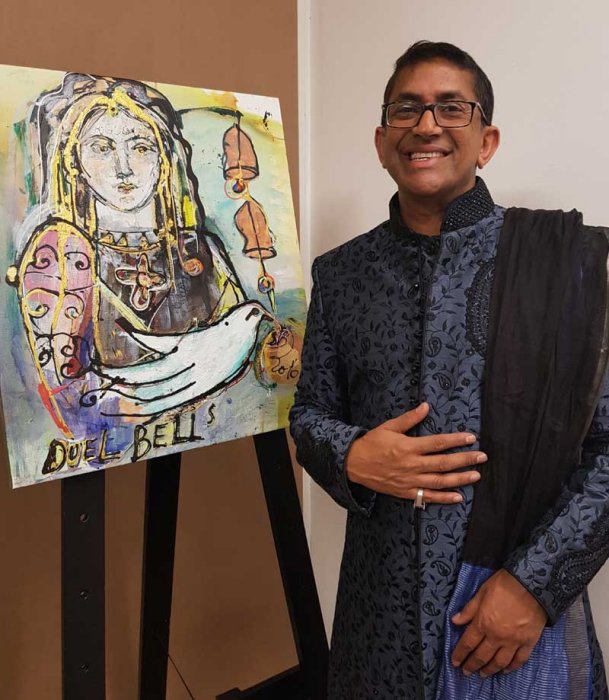 Dr. Gerard Samuel Dr. Gerard Samuel's own paper was an interesting glimpse into WHY KNOWING THE CODES WILL LEAD THE DANCE(R), although the issues raised were particular about the South African dilemma. Meeting with several artistes and Capetonians of Indian descent was fascinating, as were the many hours spent in the local markets bargaining with women at craft stalls. Among the Indian dancers, it is the Dhananjayans who are the clear favourites as gurus and idols to revere. Among the young South Africans, it is Akram Khan who has enthralled dance and theatre students. Many dancers were planning their December visits to Chennai while realising that many senior gurus are ageing and over booked and too busy to pay attention to these visiting students who pay big bucks for individual classes. The intersections of explosive South African colour and art with contemporary politics is creating many thoughtful and relevant dance and theatre works in this prosperous country. Yet, feminist presenters activist performers continue to explore the deep divisions that has left lacerations across all lives. In a city that is now considered so unsafe that I was not allowed to take my daily morning walks, I was still captivated by the immense possibilities that history, culture, race and art offer in this beautiful country. #DEBUT DRAMAS The Arangetram was and still continues to be a vital signpost in a dancer's performance arc. A series of events have brought me front and centre of this debut event in several cities. All across the world, gurus proudly proclaim yet another student at her/his first formal full length outing. However this precious moment has become sullied with the growing indiscipline of family and friends. I have personally witnessed people crisscrossing the stage with footwear, photographers rushing to the front and causing a nuisance with their obstructions, food being served while the performance is in progress - all this while the hapless guru watches, irritated and unable to respond at the unwieldy "mela". Not all arangetrams are chaotic but the ones that do not respect the true nature of the event tarnish the beautiful moment that is often the only solo performance by the artiste. Most probably, the debutante will either continue in group productions or untie the ankle bells and proceed to higher studies, marriage or a professional career that is far away from dance! #COSTUMES AND COSTUMERS  Sivakumar Aiyyelu These past few months have also brought me back to the long drawn and often harrowing saga of dance tailors and dance costumes. Having started with the legendary D S Aiyyelu five decades ago, I have had costumes designed by my mother Leela and executed by almost every well known dance tailor in Chennai. It has now been over 25 years of collaboration with design professionals in the fields of textiles and fashion for yours truly and I had lost touch with the enormous industry that dance tailors have grown into. Meeting Sivakumar, the son of Aiyyelu, at his new office revealed how much technology has aided this particular area of Indian dance. With several computers working round the clock, design templates available in an e-catalogue, branches in several countries including Singapore and the USA, costume entrepreneurs like Sivakumar have become creative businessmen to be admired. At his office, one can not only find material, dance flowers, jewellery and other accessories, but choices of matching the ankle bells with the exact colour of the costume! Coordinating the various costumes and the photo shoot for my niece for her forthcoming debut in New York City also brought me face to face with the dexterity of photo studios and photographers. Having shot so many dancers and their students over the years, these photographers have become choreographers in their own right! Suggesting poses, head tilts, arm positions, eye angles - they are conversant with the hasta-mudra terms and even have the necessary props to create the worlds of Krishna, Vishnu, Siva, Devi etc... The instant nature of digital images gives the dancer, her guru and the fond parent the freedom to look at each image and then "doctor" it with the necessary cropping, photoshopping, air brushing etc. #RETRO NOSTALGIA 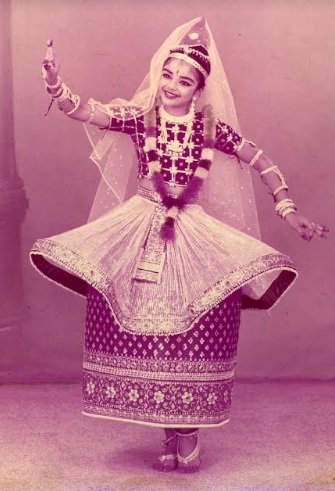
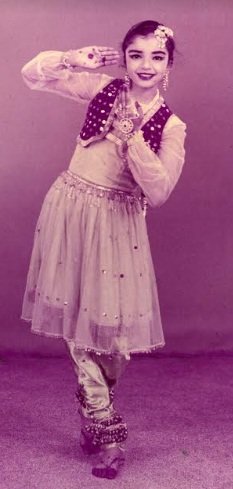 Such a stark contrast to the piles and albums of dance photos that I am currently sifting through as several media outlets continue to show renewed interest in my career. I am surprised and delighted with images that bring back those days of posing before halogen lights alongside legendary gurus and VIPs and too young to realise the importance of my role in new India's dance history. Looking at my old photos in various classical costumes reminds me of how my young body was initiated at an early stage into multiple movement vocabularies by my first guru Rajee Narayan. Clearly, she knew something even I did not know. That dance and movement from any source would be fodder for my corporeal imagination! Faded photos, reams of negatives, dog eared images, some frayed and torn - this is the true nature of those born in the fifties and sixties who have lived and danced through the many worlds of black and white photography, clunky cameras, VHS, BETACAM, VCR players. Today's world of instant talk back images and video on hand held devices seems to have come too quickly for some of us. #SALUTE TO JAYACHANDRAN 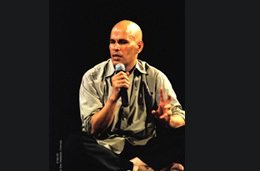 Jayachandran Palazhy Auditions continue for my new project with another India-based choreographer in Chennai and Bengaluru. Almost all the dancers who appeared have trained in contemporary movement with ATTAKKALARI / Jayachandran. It is a huge service that Jay has done quietly over the past 20 years with his media, technology and new movement centre in Bengaluru. Attakkalari's numerous courses in dance, media design have attracted many young minds and bodies. Hema Bharathy Palani is a brilliant soloist to emerge from this stable as are many more young choreographers working actively in India and elsewhere. #BODY AGAINST HATE In Delhi, the GATI Centre for contemporary performance in collaboration with 12 artistes, organised a three day dance-led protest called LONG NIGHTS OF RESISTANCE. "It was a response to the authoritarian voices of violence and hate and to articulate how protest was ingrained in the muscularity of the body," says Ranjana Dave of GATI. The performances were attended by over 100 people with many staying through the night. The GATI course for contemporary performance is off and running at Ambedkar University, New Delhi, as is the exciting new syllabus for the Madhu Nataraj led choreography course in Bengaluru. Responding to the growing interest of students from overseas to strengthen their dance knowledge and training in contemporary dance and pedagogical practice, the new NATYA INSTITUTE course aims to expand a dancer or a dance-scholar's imagination in areas like iconography, dance history, heritage design and dramaturgy. These new education modules are excellent news for the dance world. While critical theory is one area that needs to be addressed, these various initiatives are a boon to the young and the restless generation who are always looking for the next new thing! I wish I was 25 again to dive into these many opportunities. Are the global young paying attention? #CONTEMPORARY DANCE PUBLICATION 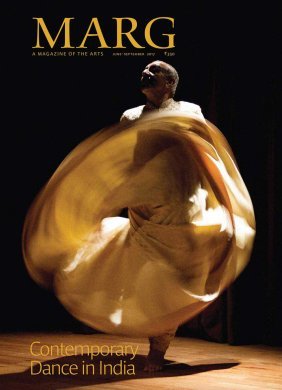 With his swirling costume on the cover, Astad Deboo makes his editorial debut with a well timed book on Indian contemporary dance. Co-edited by scholar Dr. Ketu H Katrak from the University of Irvine, California, this collection of essays from India-based practitioners comes at the exact time when many are debating the multiple worlds of classical, neo classical, contemporary and modern. While an earlier publication by GATI explored some provocative points of view (I got a mandatory single image in that edition), this MARG volume has devoted more space for those of us with a long history of embodied experience. My own essay NEO DANCE - A Personal Prism, attempts to trace my journey from the classical through the neo and now a spoken word/actor/performer. The variety of images alone is proof that so many are now populating the contemporary dance world and their journeys are very removed from the discourses used by the classical community. Among the notable essays are the editors' introduction, Leela Venkataraman's generous overview, Vikram Iyengar's thoughtful reflections and the collection on 'Pedagogy and Performances.' 'Looking Ahead' illuminates the stellar talents of well known names like Deepak Kurki, Padmini Chettur and Preethi Athreya. This affordable and very readable book costing just Rs.350 is a necessary addition to all dancers. For details 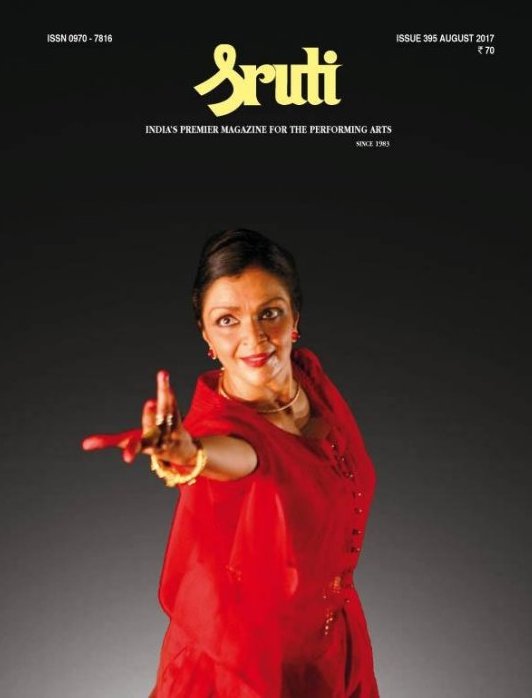
Being featured on the cover of the magazine long known as the spokesperson for classical dance and music was a genuine surprise for yours truly. The famous all red costume, designed by the ever brilliant REX and constructed by my fabulous friend Sandhya Raman, blazes on the cover. The interview, conducted by business journalist and arts afficionado Sushila Ravindranath was a different take on my career and vision. In all, it has been a month of many highlights and a chance for me to assess my own journey of 50 years. Knowing that I have lived longer than I will live is also a moment to take stock of issues like legacy, impact, voice and brand. More on that later... # PADDU-KA AT 75 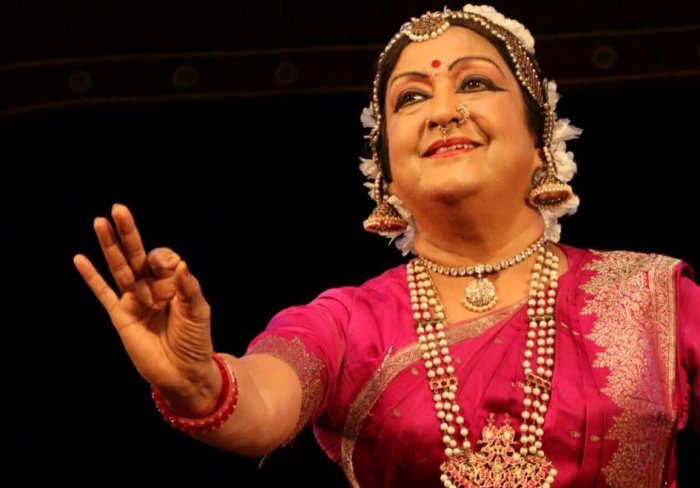 Dr. Padma Subrahmanyam Photos courtesy: Kutcheri Buzz While this Diamond Jubilee birthday milestone is very near for this dance icon, it was her institution NRITYODAYA that marked its 75th year with a 5 day mega celebration in Chennai. Packed to capacity, the Narada Gana Sabha auditorium was overflowing with celebrities and dance luminaries. Encomiums and accolades were heaped upon this dance legend who continues her stage performance with the zeal of a teenager! However the appalling technical glitches marred many guest performances who experienced abrupt stopping of the music system and lights going on and off. I did not even ask about the state of the green rooms and light bulbs, knowing full well that many out of town dancers have been appalled with the lack of basic amenities. Another dancer who hired the auditorium one month ago was told that the manager "FORGOT" to buy diesel to turn on the generator! For all those who read these thoughts in far flung corners of the world, you can be surprised, aghast or horrified. All these responses are accurate! Which brings me to the next question...  ANITA KO GUSSA KYUN AATA HAI? Kyunki... The entire sabha system in this city is in a state of collapse... or rather an implosion. All the well known auditoriums are getting more and more difficult to negotiate with. Spaces are not released until 3pm on the day of the show. Extra charges levied for rehearsals, mafia-type domination over light vendors and technicians - all work directly against any kind of aesthetic realisation. This is so exasperating and nothing short of a NO CONFIDENCE MOTION will bring the situation to light. Wishful thinking I know!!!!! This is the reason why so many dancers across India have built small spaces in their homes and are content with holding intimate shows of solos or duets without the headache of dealing with the politics of Chennai sabhas or the obdurate myopia of their local presenters. The booming popularity of Chandralekha's open air SPACES is a case in point. Every dancer wants to perform at this seaside venue despite lack of air conditioning and sophisticated tech. The natural aesthetics is inspiring on its own! What makes and keeps classical Indian dance in these suffocating ghettos? Why don't we have the respect and larger sense of pride that ballet commands with the gentrified elite in the West? Why is it that, in spite of the mandatory CSR quota in corporations, that the arts are rarely even glanced at? The fault lies with us... dancers, our families, our frog-in-the-well vision and the head-in-the-sand attitude that as long as we get the next gig, nothing else is important. Clutching onto egos and individual luminaries has done little to fertilize the field of the dance arts. Free concerts, bribes, mediocrity, appalling standards - what is the final measure of a committed professional and a rank amateur? Here Malavika Sarukkai and Geeta Chandran - both Bharatanatyam dancers - share their views on the challenges facing the professional profile of Indian dance. newindianexpress.com/magazine/... governancenow.com/news/... As we continue to create and celebrate with our bodies, let us come together during this month of festivities. The jolly pot bellied Ganesa will emerge with his love of food and merriment. July witnessed the simultaneous celebration of Aandal's birth star and the festival of Teej. No matter what faith you follow, these festivals still cling to the lunar calendar where the same day of the Brahmin thread ceremony is also the day of tying the "rakhi" by sister on a brother's wrist. Let us use these moments to remind ourselves that the body is not a site for the divisiveness of religions. The dancing body has only one faith- excellence in motion. It is like a blank canvas waiting to move, to respond, to create, to imagine and share. 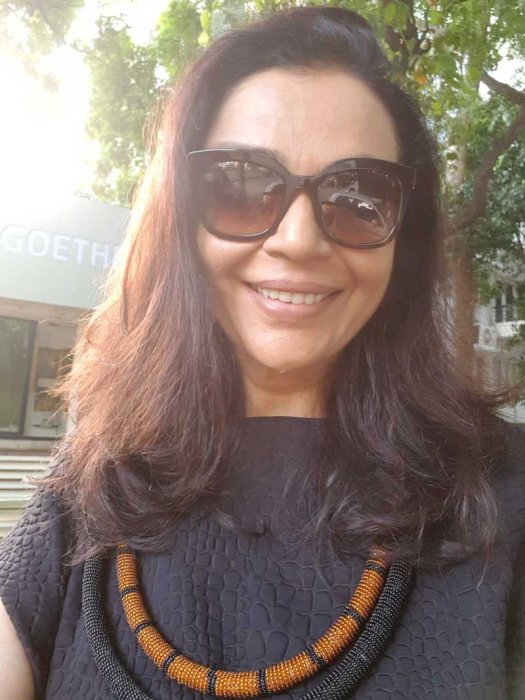 Enjoy this month that brings many friends to India to rehearse, refresh, record, recharge and rekindle friendships. I will see you somewhere on this globe but always on this portal. Dr. Anita R Ratnam Chennai/New Delhi/Mumbai/Bengaluru/Conoor PS... Chennai has opened its very first haunted/horror themed restaurant. I wanted to let the owners know that they should just invite some of the aged divas and devas or even some arangetram debutantes to perform at the venue to induce the appropriate emotion with the diners! No extra tech or imported terror gizmos are needed! Watching some recent dance dramas is an experience in sheer trauma! Twitter: @aratnam Facebook: Anita R Ratnam Instagram: @anitaratnam Blog: THE A LIST / anita-ratnam.blogspot.in Comments * I read the newsletter for the wonderful reach you have and great content. Thanks for that, and especially to read your thoughts is interesting. We all should thank you for making us reach out throughout the world. Dance is a mighty ocean but we need a chariot like Narthaki. - Prashanth Gopal Shastry, Naatyakalakshetra (Aug 29, 2017) Post your comments |